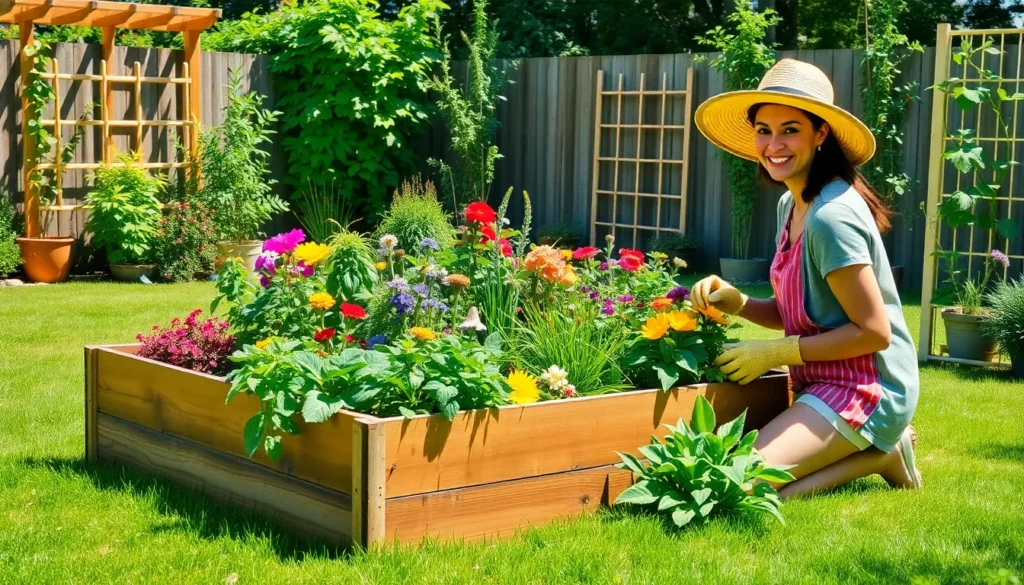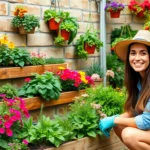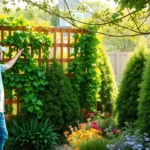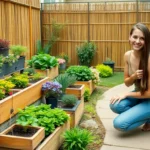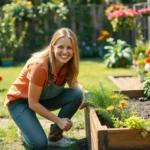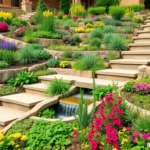We’ve all dreamed of having that perfect garden space where plants thrive and maintenance becomes a joy rather than a chore. Raised garden beds offer exactly that solution – transforming how we approach gardening by bringing plants to a more manageable height while creating defined growing spaces that look stunning in any yard.
Whether you’re dealing with poor soil conditions clay-heavy ground or simply want better drainage and pest control raised beds deliver impressive results. They’re perfect for beginners who want to start small and experienced gardeners looking to maximize their growing potential in limited space.
From simple wooden rectangles to creative tiered designs and space-saving vertical gardens the possibilities are endless. We’ll explore innovative raised bed ideas that’ll transform your outdoor space into a productive beautiful garden that works with your lifestyle and budget.
Choose the Perfect Location for Your Raised Garden Bed
Selecting the right spot for your raised bed determines whether your garden thrives or struggles. We’ll explore the key factors that transform any location into an ideal growing space.
Consider Sunlight Requirements
Most vegetables need 6 to 8 hours of direct sunlight daily to produce abundant harvests. We recommend observing your yard throughout different seasons since sun patterns change as trees leaf out and shadows shift.
Morning sun proves especially valuable because it helps dry dew from plant leaves and prevents fungal diseases. East-facing locations capture this beneficial early light while avoiding harsh afternoon heat in warmer climates.
Partial shade areas work well for leafy greens like lettuce, spinach, and kale. These crops actually prefer cooler conditions and can bolt or become bitter in intense heat. We’ve found that 4 to 6 hours of sunlight supports healthy growth for most shade-tolerant vegetables.
Track sunlight patterns in your chosen spot for at least a week before building. Take note of how many hours of direct sun the area receives and whether any structures or trees create shadows during peak growing season.
Evaluate Drainage and Water Access
Good drainage prevents waterlogged soil that kills plant roots and creates fungal problems. We suggest avoiding low-lying areas where water naturally collects after rain or irrigation.
Slightly sloped locations allow excess water to flow away naturally while still retaining enough moisture for plant needs. A gentle slope of 1 to 2 inches per foot provides ideal drainage without causing erosion problems.
Water access makes daily care much easier and encourages consistent watering habits. Position your raised bed within 50 feet of a water source to avoid dragging hoses across long distances or making multiple trips with watering cans.
Test drainage by digging a hole 12 inches deep and filling it with water. Well-draining soil allows the water to disappear within 24 hours, while clay or compacted earth may hold water for several days.
Plan for Easy Maintenance Access
Design pathways around your raised bed that allow comfortable movement during planting, weeding, and harvesting. We recommend maintaining at least 2 feet of clearance on all sides for wheelbarrow access and comfortable working space.
Consider the height of your raised bed based on your physical needs and gardening style. Standard 8 to 12 inch heights work well for most gardeners, while taller 18 to 24 inch beds reduce bending for those with mobility concerns.
Position raised beds away from overhanging branches that drop leaves, sap, or debris. These materials can block sunlight, harbor pests, and create extra maintenance work throughout the growing season.
Plan for tool storage and compost access near your raised bed location. Having essential supplies within easy reach saves time and energy during routine garden tasks.
Select the Right Materials for Your Raised Garden Bed Frame
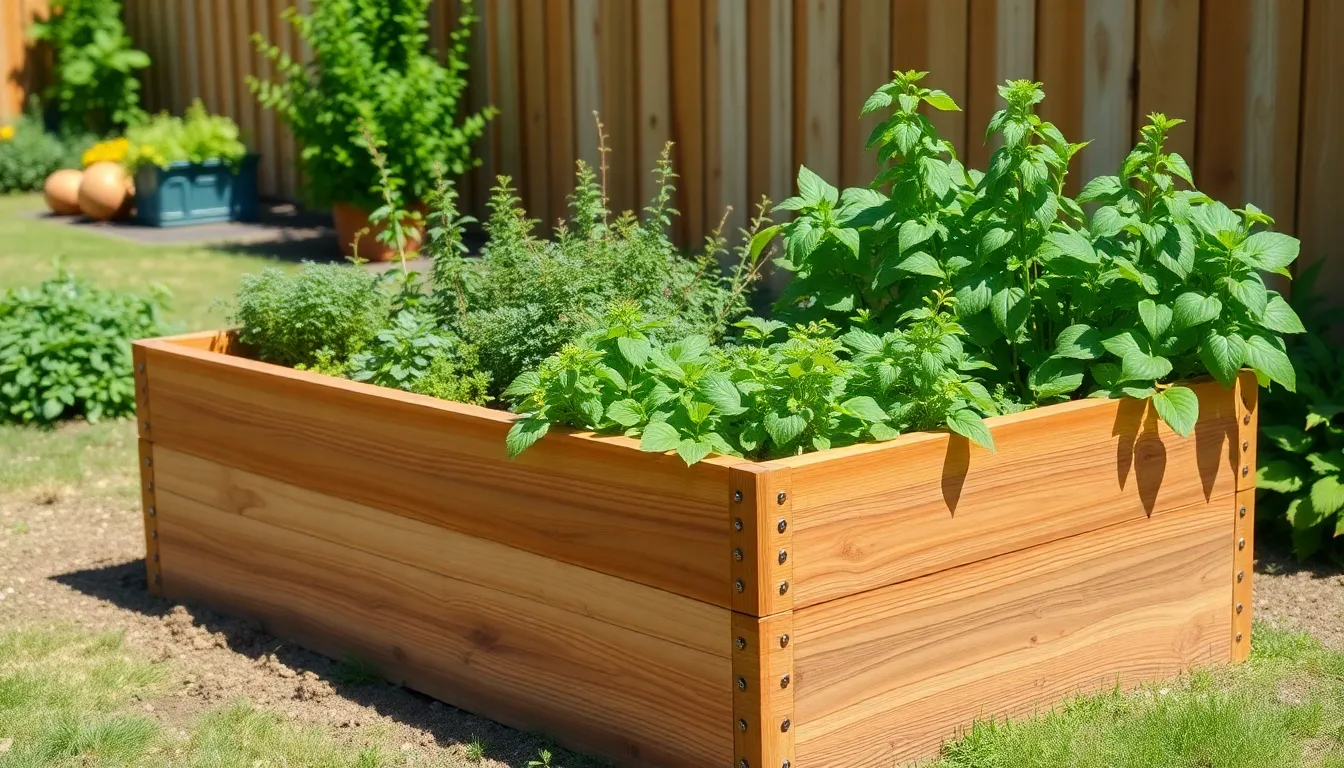
Selecting the right frame material determines both the longevity and appearance of your raised garden bed. Budget, sustainability goals, and maintenance preferences all influence this crucial decision.
Wood Options for Natural Appeal
Cedar and redwood stand out as premium choices for raised garden bed construction due to their exceptional resistance to rot and insect damage. Cedar typically costs less than other hardwoods while maintaining superior durability compared to softwood alternatives like pine.
Untreated wood offers the safest option for growing edible plants since it prevents harmful chemicals from leaching into your soil. Apply food safe wood preservatives to extend the lifespan of untreated lumber without compromising plant health.
Pine and other softwoods provide budget friendly alternatives when treated with natural preservatives. These materials work well for temporary installations or gardeners testing raised bed concepts before investing in premium options.
Metal Materials for Durability
Steel frames deliver exceptional longevity at costs significantly lower than stone installations. Galvanized steel resists rust and corrosion while maintaining structural integrity through multiple growing seasons.
Aluminum options weigh considerably less than steel alternatives while offering similar durability benefits. This lightweight characteristic makes aluminum ideal for rooftop gardens or situations requiring frequent bed relocation.
Corrugated metal panels create attractive modern designs that complement contemporary industry styles. These materials conduct heat efficiently, extending growing seasons in cooler climates while requiring minimal maintenance.
Composite and Recycled Materials for Sustainability
Composite materials blend wood fibers with recycled plastics to create boards that resist rot, insects, and weather damage. These products maintain the natural wood appearance while eliminating annual treatment requirements.
Recycled plastic lumber offers excellent moisture resistance and comes from post consumer waste materials like milk jugs and detergent containers. This option supports environmental sustainability while providing decades of maintenance free service.
Repurposed materials like old pallets reduce construction costs significantly when properly prepared and treated. Stone blocks, bricks, and concrete pavers salvaged from other projects create unique raised bed designs while diverting waste from landfills.
Determine the Ideal Size and Height for Your Garden Bed
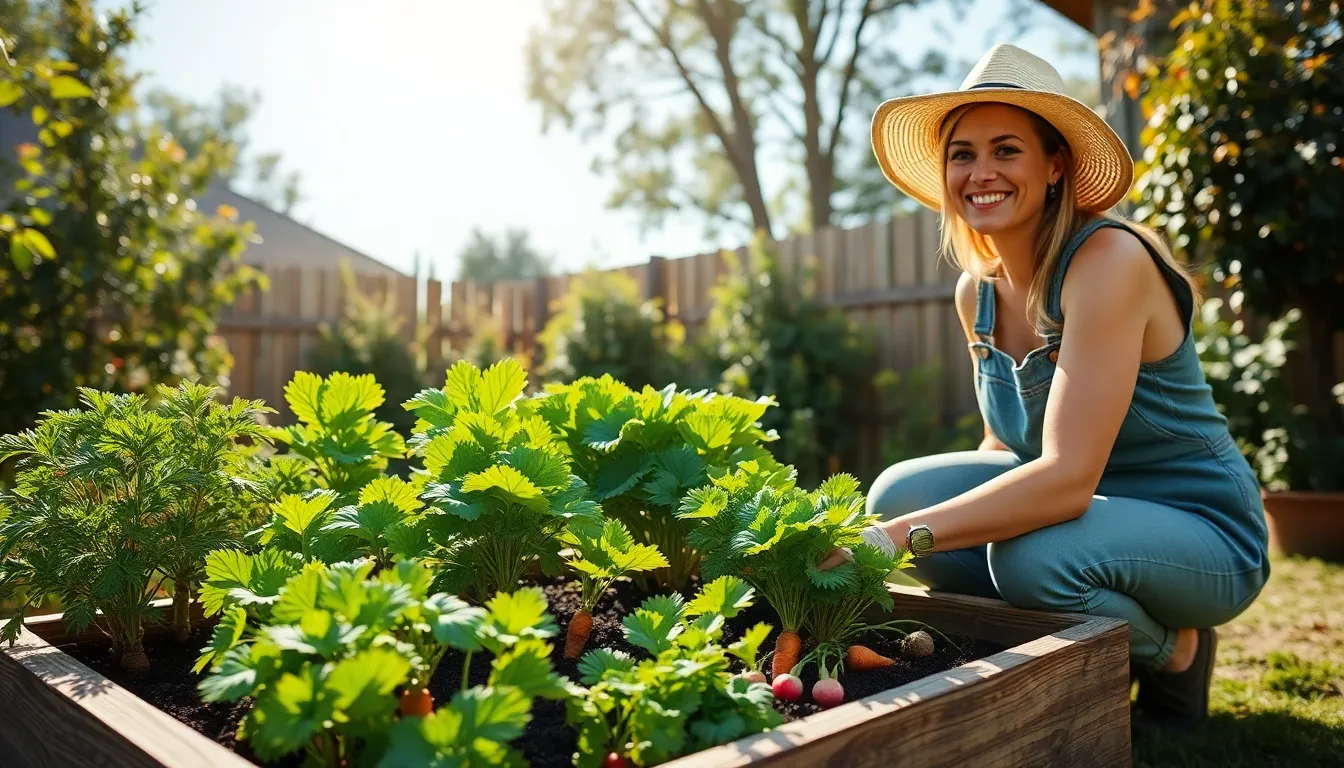
Now that we’ve selected our materials, we need to plan the dimensions that’ll make our raised garden bed both productive and comfortable to maintain. Getting the size and height right from the start saves us time and effort throughout the growing season.
Standard Dimensions for Easy Reach
Standard raised garden beds work best at 4 feet wide and 8 feet long, providing an excellent balance between planting space and accessibility. This popular size allows us to comfortably reach the center from either side without stepping on the soil or straining our backs.
Width measurements should range from 18 inches to 4 feet depending on who’ll be using the garden bed. We recommend 3 feet wide for children’s gardens, while 4 feet works perfectly for adult gardeners. For wheelchair accessibility, we suggest keeping the width at 2 feet maximum to ensure comfortable reach across the entire bed.
Length typically ranges from 4 to 10 feet for most home gardens, with 8 feet being the sweet spot for efficient planting and harvesting. Compact spaces benefit from 3 feet wide and 4 feet long dimensions, creating manageable growing areas that still provide adequate planting room.
Deep Bed Options for Root Vegetables
Deep beds measuring 18 inches or more offer superior drainage that’s essential for growing root vegetables like carrots, beets, and radishes. These vegetables need loose, well draining soil to develop their underground portions properly.
Heights up to 36 inches work exceptionally well for root vegetables that require deeper soil penetration. We’ve found that carrots and parsnips thrive in these deeper beds, developing fuller, straighter roots without hitting compacted ground beneath.
Minimum height should be 6 inches, though 24 inches provides the ideal depth for both drainage and comfort during maintenance. The extra height reduces back strain while weeding and harvesting, making garden work more enjoyable for extended periods.
Narrow Bed Designs for Small Spaces
Narrow beds at 2 feet wide maximize growing space in areas with limited square footage or tight garden layouts. These slim designs work perfectly along fence lines, walkways, or between existing industry features.
Small space gardens benefit from narrow bed designs that can be combined with container gardening to optimize every available inch. We can create productive growing areas even in compact urban settings or small backyards using this approach.
Low maintenance gardens thrive with narrow bed configurations since they’re easier to weed, water, and harvest. The reduced width means we can complete garden tasks quickly while still enjoying fresh vegetables and herbs throughout the growing season.
Create Themed Raised Garden Beds for Specific Plants
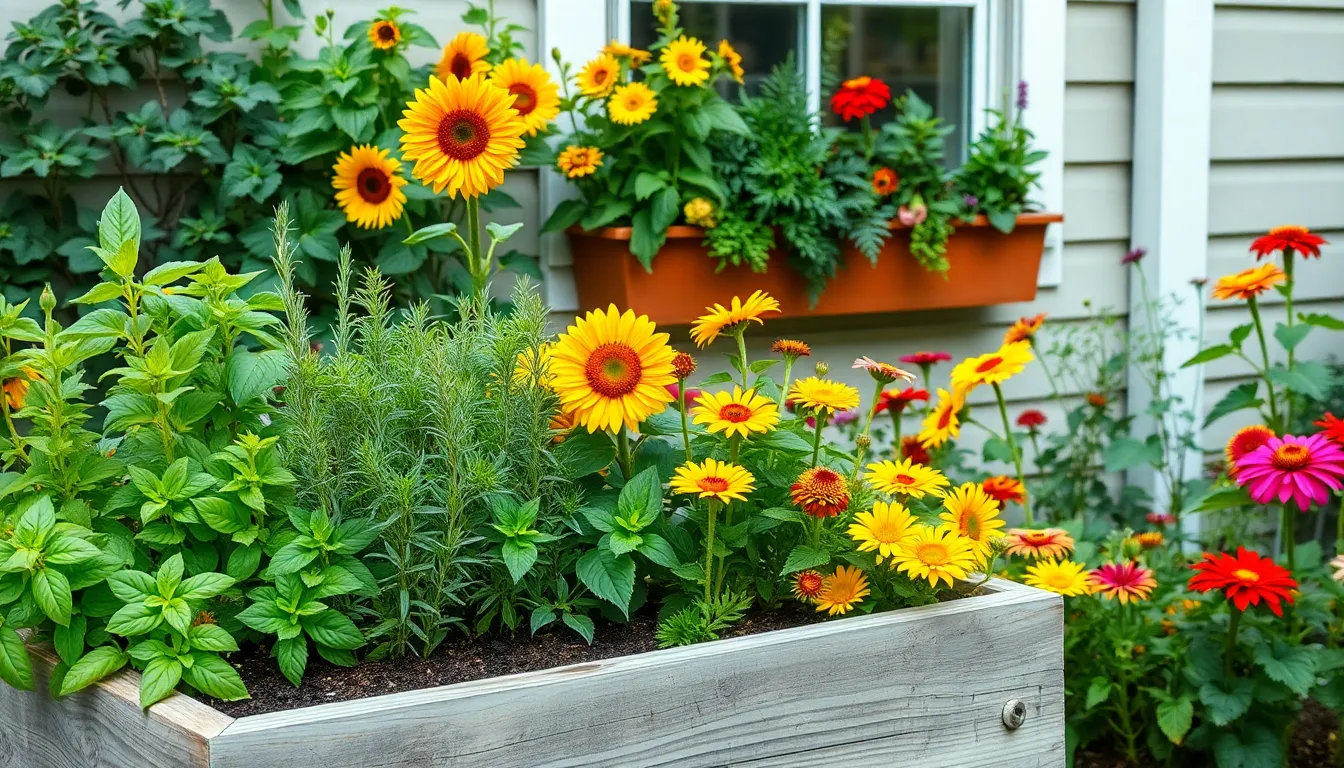
Themed raised garden beds transform ordinary growing spaces into specialized areas that serve exact purposes and create visual interest. We can organize our gardens around particular plant families or intended uses to maximize both functionality and aesthetic appeal.
Herb Garden Bed Layout
Herbal tea beds offer a delightful way to grow peppermint, chamomile, and lavender specifically for brewing homemade teas. We position these aromatic plants in a dedicated raised bed near our kitchen for easy harvesting during cooking or tea preparation.
Window box herb gardens work perfectly for small spaces where we can cultivate basil, rosemary, and thyme within arm’s reach of our cooking area. These compact raised beds fit snugly against exterior walls and provide fresh herbs throughout the growing season.
Trellis support systems enhance herb garden productivity by accommodating climbing varieties like mint or vertical growing rosemary. We install these structures within our raised beds to maximize growing space while keeping aggressive spreaders like mint contained.
Vegetable Garden Bed Organization
Salad gardens concentrate on growing greens, tomatoes, and cucumbers to create complete fresh meal components in one dedicated space. We arrange these complementary plants to ensure easy harvesting of ingredients for daily salads and cooking needs.
Grid wiring systems help us organize and support vegetables like tomatoes and cucumbers within our raised bed structures. These wire frameworks provide essential support for heavy fruiting plants while maintaining neat, accessible growing arrangements.
Row planting maximizes space efficiency in vegetable beds by organizing crops in straight lines that help maintenance and harvesting. We carry out this systematic approach to ensure proper spacing and easy access to all plants throughout the growing season.
Flower Garden Bed Arrangements
Triangular raised garden beds create visually striking focal points for flowers like sunflowers or zinnias while fitting perfectly into corner spaces. We design these geometric beds to add architectural interest to our garden layout while maximizing planting area.
Mixed plantings combine flowers with herbs or vegetables to attract beneficial pollinators and add vibrant color throughout our growing space. We strategically place flowering plants alongside edible crops to create productive ecosystems that support both beauty and harvest.
Polyculture planting brings together vegetables, herbs, and flowers in diverse combinations that create thriving, balanced garden ecosystems. We use this approach to maximize biodiversity while reducing pest problems and improving soil health naturally.
Design Multi-Level Raised Garden Bed Systems

We’re transforming traditional raised garden beds into stunning vertical displays that maximize growing space while creating impressive focal points in our outdoor areas.
Tiered Garden Bed Construction
Build sturdy frames using composite or wood materials to ensure your multi-level system withstands weather and weight over time. We recommend cedar and redwood for their natural rot resistance, while composite materials offer excellent durability with minimal maintenance requirements.
Stack individual raised beds at different heights to create visual depth and accommodate various plant growth requirements. Each tier should measure between 12 to 18 inches deep, allowing adequate root space for vegetables and herbs in upper levels while providing deeper growing areas for root crops below.
Install proper drainage systems between each level to prevent water accumulation and root rot. We suggest drilling drainage holes in upper tiers and adding gravel layers to help water movement throughout the entire structure.
Design each level with different dimensions to create an aesthetically pleasing stepped appearance. Consider making the bottom tier 8 feet by 4 feet, the middle tier 6 feet by 3 feet, and the top tier 4 feet by 2 feet for a pyramid effect.
Stepped Garden Bed Arrangements
Create level garden surfaces on sloping yards by constructing stepped raised beds that follow your industry’s natural contours. This design transforms challenging terrain into productive growing space while preventing soil erosion.
Widen each step gradually to accommodate layered flower gardens and vegetable borders, making maintenance and harvesting more accessible. We recommend increasing width by 6 to 12 inches with each descending level to create adequate planting zones.
Plan accessible pathways between each step to ensure easy movement during garden maintenance. Steps should rise no more than 8 inches to maintain comfortable access for all gardeners, regardless of mobility levels.
Position taller plants on higher levels and shorter varieties on lower tiers to prevent shading issues. This arrangement ensures all plants receive adequate sunlight while creating a natural amphitheater effect in your garden space.
Cascading Garden Bed Designs
Select plants with varying heights and growth habits to achieve the dramatic cascading effect that makes these designs so visually striking. Trailing varieties like cherry tomatoes, nasturtiums, and strawberries work excellently in upper tiers.
Incorporate vertical growing supports such as trellises and arbors to maximize space utilization and support climbing plants. These structures enhance your garden’s visual appeal while providing additional growing surfaces for vining crops.
Layer flowering plants strategically to create continuous color throughout growing seasons, with early bloomers in lower tiers and late season varieties cascading from upper levels. This approach ensures your garden maintains visual interest from spring through fall.
Combine different textures and foliage colors to enhance the cascading effect, using plants with contrasting leaf shapes and colors to create depth and movement in your design. Consider pairing broad leafed plants with fine textured grasses or herbs for maximum visual impact.
Incorporate Creative Shapes and Patterns
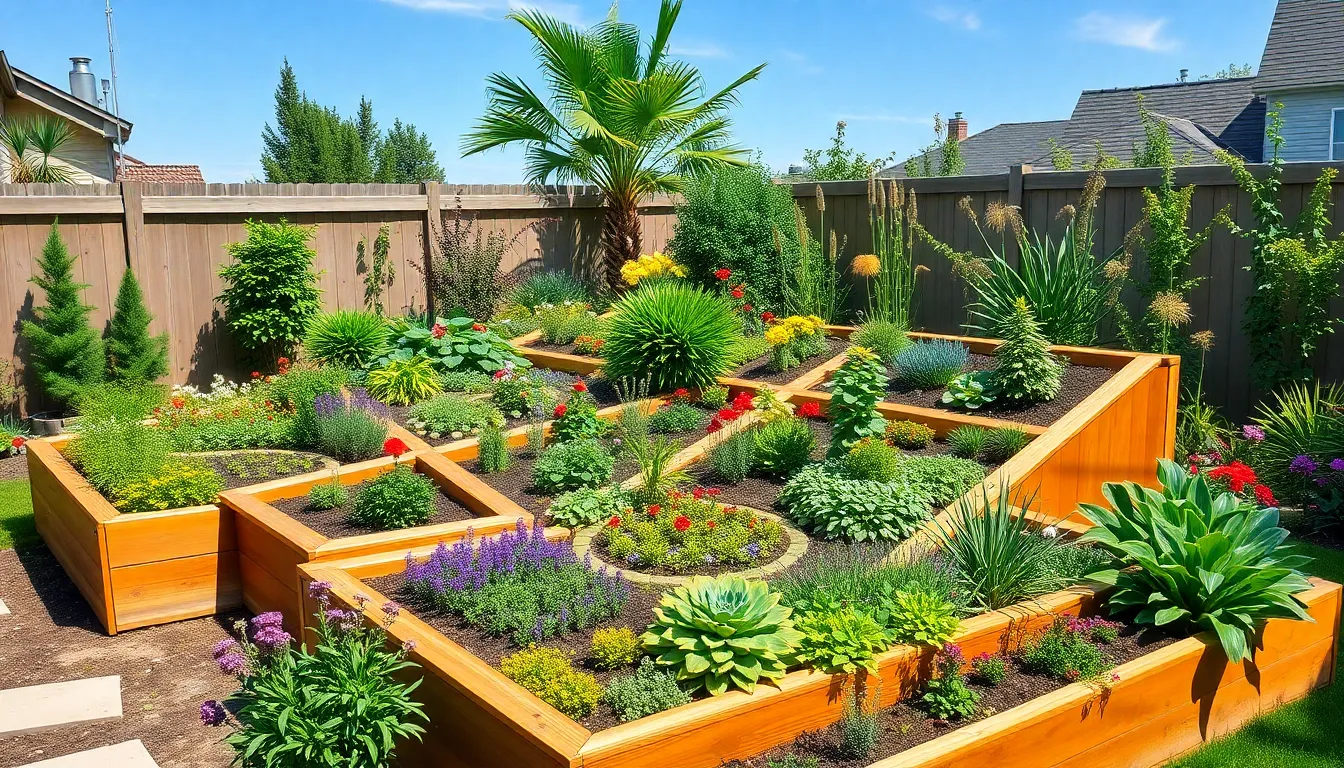
Moving beyond traditional rectangular designs opens up exciting possibilities for creating raised garden beds that serve as stunning industry features. We can transform our gardens into works of art by experimenting with innovative shapes and geometric arrangements.
Geometric Garden Bed Designs
Grid patterns create organized growing spaces that maximize both functionality and visual appeal. We recommend using grid wiring to establish geometric layouts within the bed, which helps organize plants systematically while creating an aesthetically pleasing structure. These patterns work exceptionally well for herb gardens and vegetable plots where organization enhances harvesting efficiency.
Triangular raised garden beds prove ideal for small spaces and corner areas where traditional rectangular beds won’t fit. These unique shapes add visual interest to our garden design and create striking patterns when we combine multiple triangular beds together. The pointed configuration allows us to maximize growing space in tight corners while creating ever-changing focal points.
Multi-level geometric beds introduce depth and dimension to our garden industry. Building beds with different tiers allows us to grow various plants at optimal heights while creating a sophisticated architectural element. Square and rectangular modules can stack and combine to form complex geometric arrangements that transform ordinary gardens into extraordinary displays.
Curved and Circular Garden Beds
Circular beds create stunning focal points that draw the eye and anchor garden designs effectively. These rounded structures often require less space than rectangular alternatives while providing easier access from all sides for maintenance and harvesting. We find circular beds particularly effective for herb gardens and ornamental displays where the curved shape complements natural plant growth patterns.
Crescent-shaped beds maximize growing space while creating unique garden layouts that flow naturally with industry contours. These curved designs work beautifully for perimeter plantings and border gardens where we want to soften hard industry edges. The curved form allows for creative plant arrangements that follow the natural flow of the bed’s shape.
Serpentine bed configurations offer ever-changing alternatives to straight lines and rigid patterns. We can create winding raised beds that snake through our garden space, providing extensive growing areas while maintaining an organic, natural appearance. These flowing designs work particularly well for larger properties where we want to create distinct garden rooms and pathways.
Keyhole Garden Bed Configuration
Keyhole designs revolutionize raised bed accessibility by incorporating central pathways that allow easy access to all growing areas. This highly efficient configuration involves creating a raised bed with a central access point, eliminating the need to walk on growing soil while maintaining plants. The design proves especially valuable for small spaces where we need to maximize both growing area and accessibility.
Central composting systems integrate seamlessly with keyhole bed designs, creating self-sustaining growing environments. We can build a central composting basket within the keyhole structure, allowing organic waste to decompose directly into the growing medium. This configuration provides continuous nutrient cycling while maintaining easy access to all planted areas.
Accessibility pathways within keyhole designs accommodate gardeners with mobility challenges or those who prefer comfortable maintenance positions. The central access point allows us to reach every section of the bed without stretching or stepping on growing soil, making gardening more enjoyable and sustainable for long-term use.
Add Functional Features to Your Raised Garden Bed
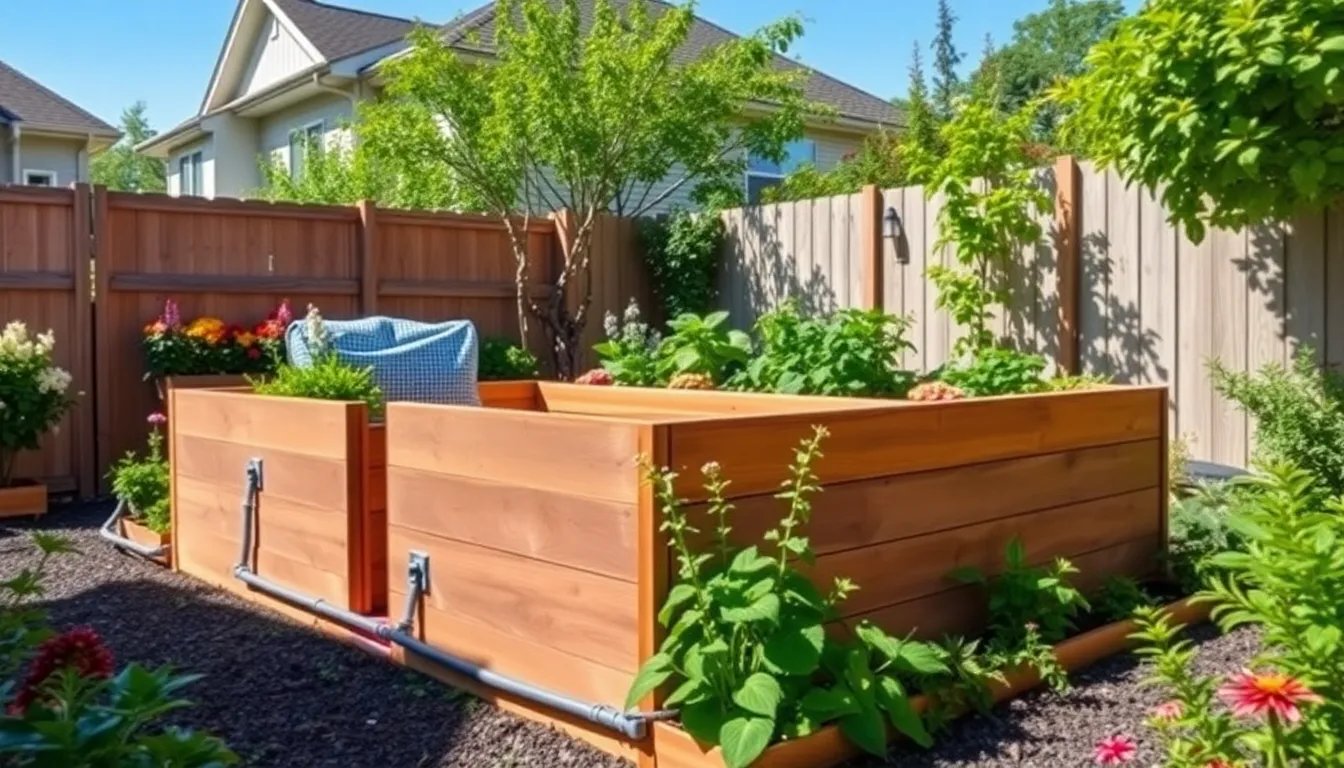
We can transform ordinary raised beds into highly functional garden spaces by incorporating smart features that enhance both usability and efficiency. These thoughtful additions make gardening more enjoyable while solving common challenges we face in outdoor growing spaces.
Built-In Seating and Storage
Built-in benches create perfect resting spots while we tend to our gardens, especially useful for long narrow raised beds where we need frequent breaks. We can incorporate these seats directly into the bed design, using the same materials as our frame for a cohesive look. Storage compartments beneath the seating or within the bed sides keep our gardening tools and supplies organized and easily accessible. These hidden storage areas protect our equipment from weather while maintaining the bed’s clean appearance.
Under-seat storage works particularly well for frequently used items like hand tools, gloves, and small watering equipment. We can design flip-top bench seats or sliding drawer systems depending on our carpentry skills and budget. The storage integration eliminates trips back and forth to the shed, making our gardening sessions more efficient and enjoyable.
Irrigation System Integration
Drip irrigation systems deliver water directly to plant roots, reducing waste and improving water efficiency throughout our growing season. We can install these systems during bed construction or retrofit existing beds with minimal disruption to established plants. Rainwater collection systems connected to our irrigation setup reduce water bills while supporting environmental sustainability goals.
Automated timers paired with drip systems ensure consistent watering schedules even when we’re away from home. We can customize watering zones for different plant types, giving thirsty vegetables more water while conserving moisture for drought-tolerant herbs. The direct root watering approach prevents fungal diseases that often develop when we water plant leaves and stems.
Rain barrel integration captures natural precipitation that would otherwise run off our roofs and gutters. We can connect these collection systems directly to our drip lines, creating a sustainable water cycle for our raised beds.
Pest Protection Answers
Row covers made from lightweight fabric protect our plants from common garden pests like aphids and whiteflies without blocking sunlight or air circulation. We can easily remove these covers for harvesting or maintenance, then replace them quickly when pest pressure increases. Copper tape applied around the bed perimeter creates an effective barrier against slugs and snails, which won’t cross over copper surfaces.
Grid wiring systems train vining plants while creating natural pest barriers through organized plant spacing. We can install these grids during planting season, then remove them after harvest for easy bed preparation. The organized plant arrangement also makes it easier to spot pest problems early and apply targeted treatments.
Physical barriers like fine mesh screens can protect seedlings from larger pests such as birds and rabbits. We can create removable covers using PVC frames and hardware cloth, allowing easy access for routine care while maintaining protection during vulnerable growth stages.
Build Raised Garden Beds for Different Seasons
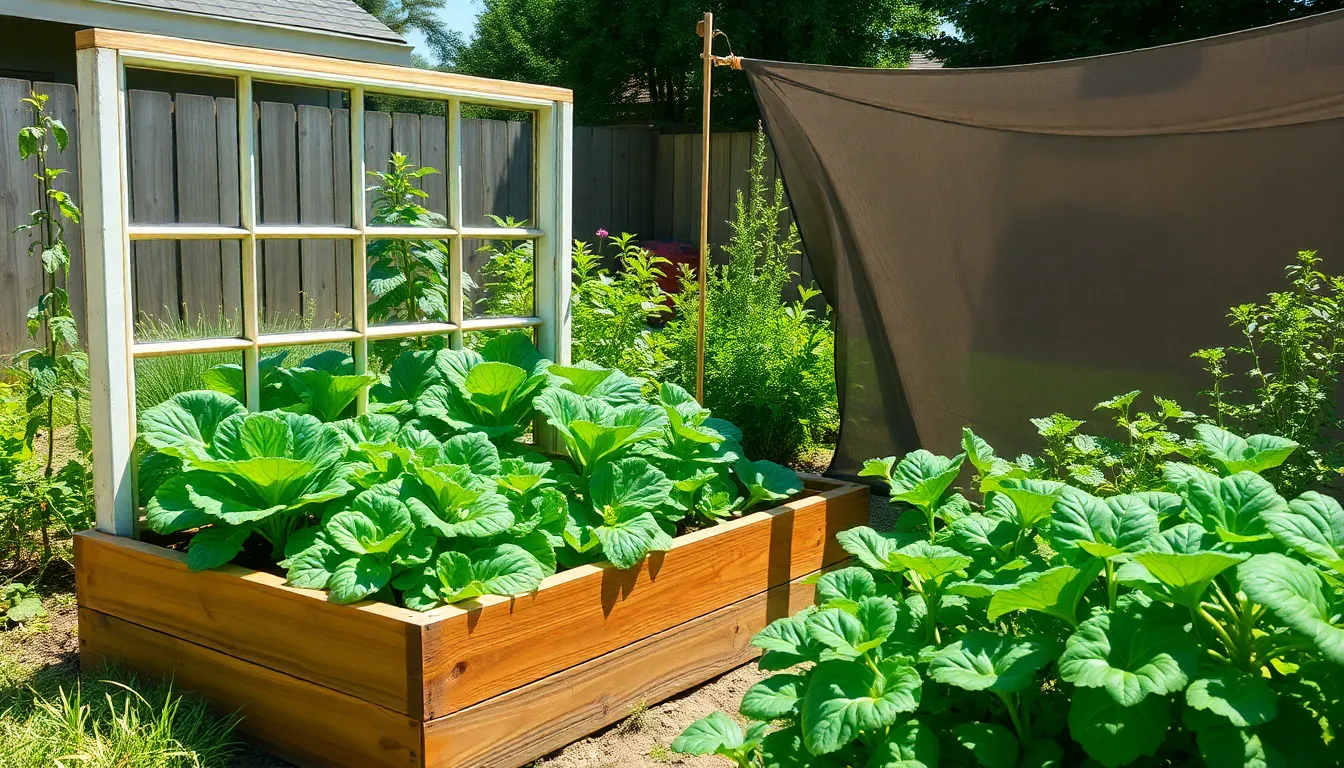
We can transform our raised garden beds into year-round growing powerhouses by incorporating seasonal adaptations that protect plants and extend harvest periods.
Cold Frame Attachments for Winter Growing
Winter gardening becomes achievable when we attach cold frames to our raised garden beds. These protective structures create a microclimate that shields plants from frost while providing essential insulation during harsh weather conditions. We can easily construct cold frames using recycled windows or clear polycarbonate panels that trap solar heat during the day and release it slowly at night.
Cold frame attachments allow us to grow cold-hardy vegetables like kale, spinach, and lettuce throughout winter months. The combination of raised bed soil drainage and cold frame protection creates optimal conditions for continuous harvests even when temperatures drop below freezing. We’ll find that these winter growing systems require minimal maintenance while delivering fresh produce when grocery store prices peak.
Shade Structure Additions for Summer
Summer heat protection becomes crucial for maintaining healthy plants during intense growing seasons. We can incorporate shade structures like adjustable canopies, umbrellas, or shade cloth frameworks that filter harsh sunlight while maintaining adequate light levels for photosynthesis. These additions help prevent heat stress, reduce water evaporation, and extend the growing season for cool-weather crops.
Shade structures work particularly well for protecting leafy greens, herbs, and transplants from scorching afternoon sun. We can install removable shade systems that adjust throughout the season, providing flexibility as weather patterns change. The strategic placement of these protective elements creates comfortable microclimates that support diverse plant varieties during peak summer months.
Season Extension Techniques
Early planting opportunities multiply when we use raised beds’ natural warming properties combined with protective covers. Raised garden beds warm up faster than ground-level soil, allowing us to start spring plantings weeks earlier than traditional gardens. Row covers and frost blankets provide additional protection during unexpected cold snaps, safeguarding our investment in early season crops.
Protective covering techniques help us extend fall harvests well into winter months. We can layer different protection methods, using row covers for light frost protection and adding cold frames for more severe weather conditions. These season extension strategies maximize our garden productivity while reducing dependency on store-bought produce during off-season months.
Maximize Small Space Raised Garden Bed Ideas
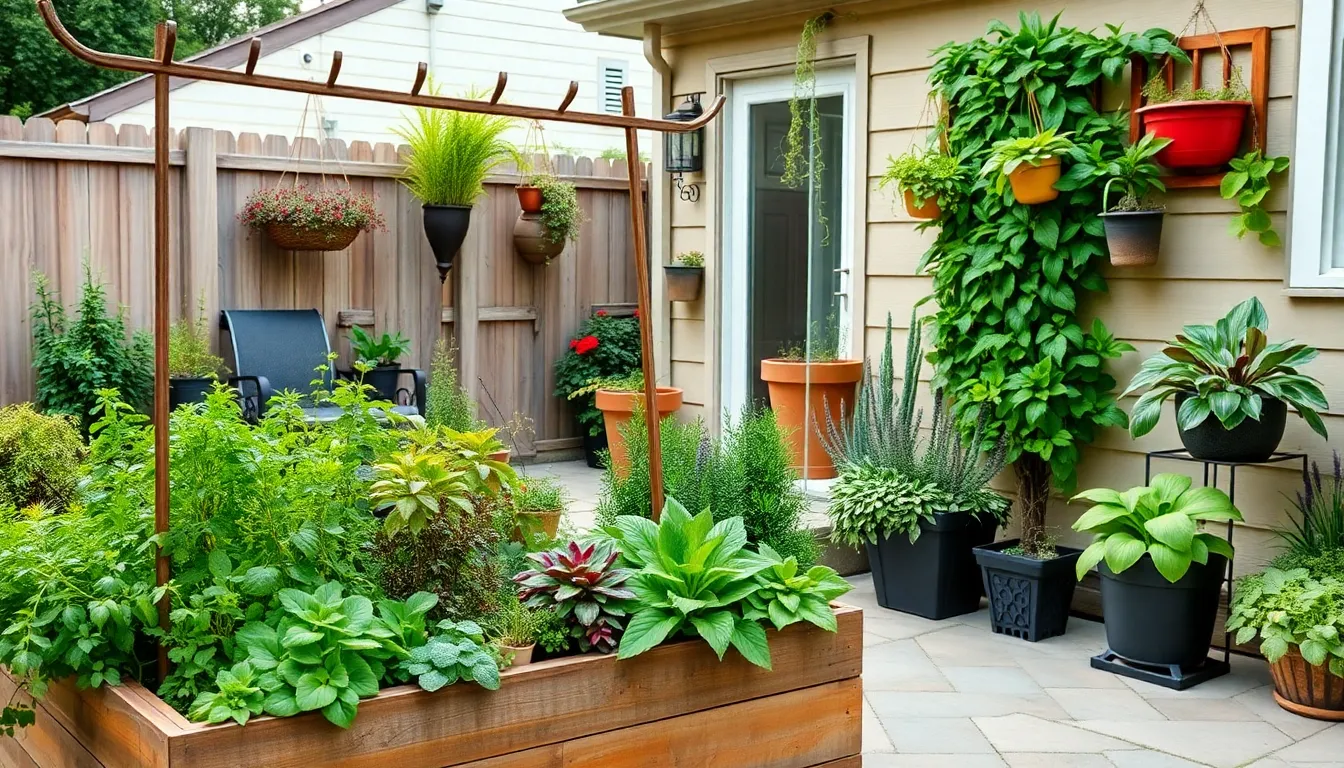
Small spaces don’t have to limit our gardening dreams. We can create productive raised garden beds that maximize every square inch through strategic design choices.
Vertical Growing Answers
Trellises transform our growing capacity by supporting climbing plants like peas, beans, and tomatoes while optimizing vertical space. We’ll position obelisk or arch trellises within our raised beds to create stunning focal points that support heavy vine crops. These structures allow us to grow upward instead of outward, doubling or tripling our harvest potential.
Wall mounted planters extend our garden beyond traditional bed boundaries by utilizing unused vertical surfaces. We can attach these planters directly to fences, garage walls, or patio surfaces to create dedicated spaces for herbs like basil, oregano, and thyme. This approach works particularly well for lightweight plants that don’t require deep root systems.
Living walls create dramatic visual impact while maximizing our growing space through creative vertical arrangements. We’ll install multiple tiers of wall mounted containers to establish cascading gardens of succulents, strawberries, or lettuce varieties. These installations can transform blank exterior walls into productive growing surfaces.
Corner and Wall-Mounted Options
Corner planters use forgotten spaces by fitting perfectly into tight angles where traditional rectangular beds won’t work. We can design triangular or specially shaped corner units that accommodate different plant types while making efficient use of awkward spaces. These planters work exceptionally well for herb gardens or compact vegetable varieties.
Wall mounted gardens create living displays that bring our growing efforts to eye level for easy maintenance and harvesting. We’ll secure sturdy brackets to exterior walls and install planters at comfortable working heights. This positioning makes watering, pruning, and harvesting simple tasks that don’t require bending or kneeling.
Fence line installations maximize boundary spaces by converting property lines into productive growing areas. We can mount shallow planters along existing fences to create herb walls or flower borders that enhance privacy while producing fresh ingredients for our kitchen.
Container and Portable Designs
Portable raised beds offer flexibility through wooden or galvanized metal containers that move easily to different locations as our needs change. We’ll choose lightweight materials and add wheels or handles to these beds for seasonal repositioning. This mobility allows us to follow optimal sun patterns throughout the year.
Container gardens accommodate varying plant needs through different sized vessels that support everything from deep rooted tomatoes to shallow lettuce crops. We can select containers ranging from 6 inches deep for herbs to 18 inches deep for root vegetables. This approach lets us customize growing conditions for each plant type.
Modular systems create adaptable layouts that grow with our gardening experience and space requirements. We’ll invest in stackable or connecting containers that allow us to expand our garden incrementally. These systems work particularly well for renters who need temporary answers that won’t damage property.
Enhance Your Raised Garden Bed with Companion Features
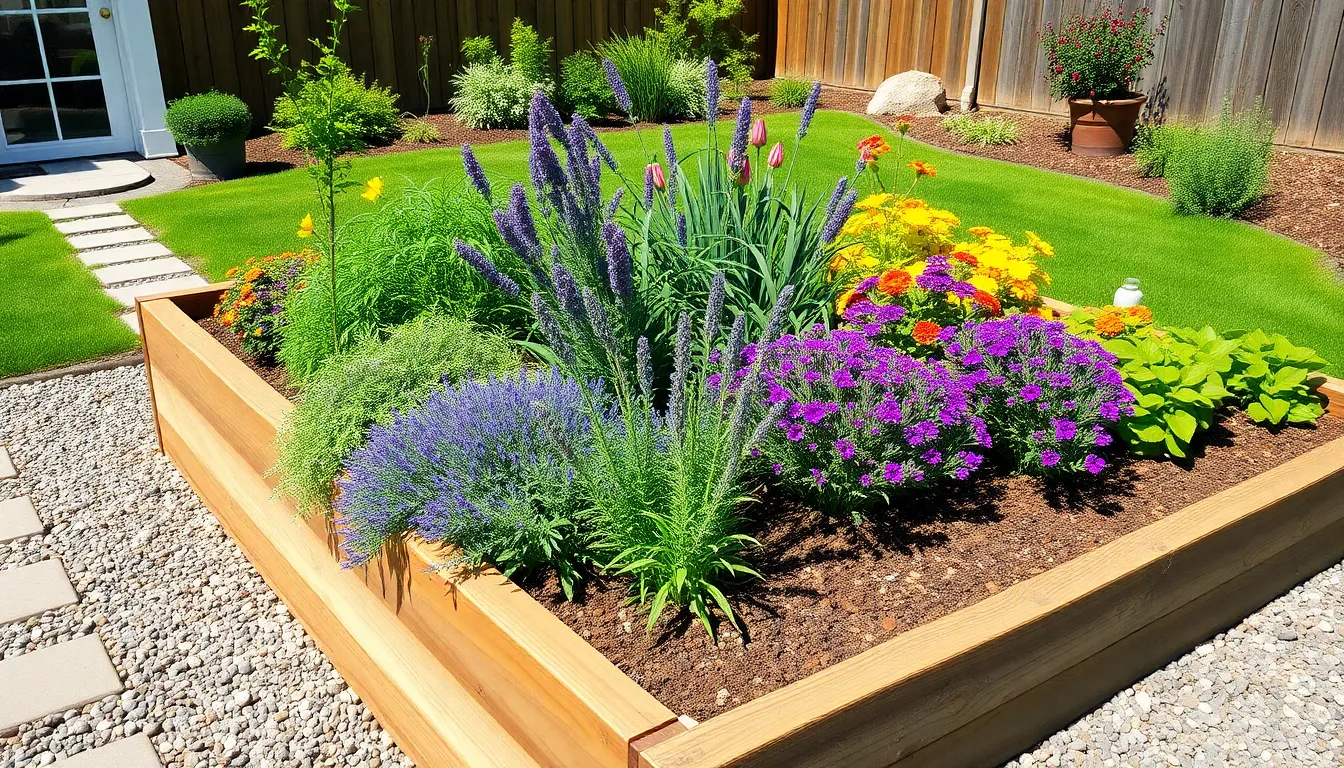
Transforming your raised garden bed into a cohesive industry design requires thoughtful companion features that enhance both functionality and visual appeal. We’ll explore practical additions that create seamless integration between your beds and the surrounding garden space.
Pathway and Mulch Integration
Pathways between your raised beds create essential access routes for maintenance and harvesting while preventing soil compaction from foot traffic. Gravel offers excellent drainage and a clean appearance that complements most garden styles. Wood chips provide a natural look that breaks down over time to enrich the surrounding soil. Stone pathways deliver durability and can handle heavy foot traffic during wet conditions.
Mulch application around your beds serves multiple purposes beyond pathway definition. We recommend spreading a 2-3 inch layer to retain soil moisture and reduce watering frequency by up to 50%. Weed suppression becomes significantly easier when mulch blocks sunlight from reaching unwanted seeds. Aesthetic enhancement occurs naturally as mulch creates clean lines that define your garden’s structure and unify different bed materials.
Spacing your pathways 2-3 feet wide ensures comfortable movement while carrying tools or harvest baskets. Materials like bark chips cost approximately $30-40 per cubic yard and last 2-3 seasons before needing replacement.
Decorative Edging and Borders
Edging materials transform basic raised beds into polished industry features that increase your property’s visual appeal. Wood edging using cedar or redwood boards creates natural borders that age gracefully and resist decay for 8-10 years. Brick provides timeless elegance and can be laid in various patterns to match your home’s architectural style. Metal edging offers clean, modern lines that work particularly well with contemporary garden designs.
Installation depth matters significantly for edging effectiveness. We suggest burying materials at least 4-6 inches deep to prevent grass encroachment and maintain crisp borders. Cost considerations vary widely, with treated lumber averaging $3-5 per linear foot while decorative stone can reach $15-20 per linear foot.
Herb borders around your raised bed perimeters serve dual purposes as living decoration and functional garden elements. Lavender plantings deter pests naturally while attracting beneficial pollinators like bees and butterflies. Oregano creates aromatic borders that release pleasant scents when brushed against during garden work. These herb borders typically extend 12-18 inches from bed edges and require minimal maintenance once established.
Companion Planting Strategies
Polyculture planting maximizes your raised bed space while improving overall soil health through diverse root systems and nutrient cycling. Tomatoes paired with lettuce underneath create efficient vertical space usage since lettuce thrives in the partial shade cast by tomato plants. This combination can increase your harvest yield by 40-60% compared to single crop plantings.
Salad garden combinations offer fresh ingredients within arm’s reach of your kitchen. Tomatoes, lettuce, radishes, and carrots grown together provide varied textures, flavors, and harvest times that extend your fresh produce availability. Radishes mature in just 25-30 days, providing quick satisfaction while slower crops like tomatoes develop over 70-80 days.
Three sisters planting represents traditional companion strategies that we can adapt for raised beds. Corn provides natural trellising for climbing beans while squash spreads at ground level to suppress weeds and retain moisture. These partnerships reduce the need for external support structures and create self sustaining plant communities that require less intervention from gardeners.
Conclusion
Raised garden beds offer endless possibilities for creating productive and beautiful growing spaces that work with your lifestyle and budget. Whether you’re working with a sprawling backyard or a compact patio the key lies in thoughtful planning and creative design choices.
We’ve explored everything from material selection and seasonal adaptations to space-maximizing vertical answers and companion planting strategies. These techniques help you build gardens that aren’t just functional but truly inspiring.
The beauty of raised bed gardening is its adaptability – you can start small and expand over time or customize features that meet your exact needs. With the right approach your raised garden bed becomes more than just a place to grow plants – it becomes a focal point that enhances your entire outdoor space while providing fresh produce year-round.
Frequently Asked Questions
What are the main benefits of raised garden beds?
Raised garden beds offer improved drainage, better soil control, and easier pest management. They make gardening more accessible by reducing bending and provide better growing conditions than ground-level gardens. They’re perfect for overcoming poor soil conditions and creating organized, visually appealing growing spaces.
How much sunlight do raised garden beds need?
Raised garden beds should receive 6 to 8 hours of direct sunlight daily for optimal plant growth. Choose locations that aren’t shaded by buildings or trees, and avoid low-lying areas prone to water accumulation for proper drainage.
What materials work best for raised garden bed frames?
Popular materials include premium woods like cedar and redwood, treated pine, metal materials, and repurposed items. Your choice depends on budget, sustainability goals, and desired longevity. Cedar and redwood naturally resist rot, while metal options offer durability.
What’s the ideal size for raised garden beds?
Standard raised beds are typically 4 feet wide for easy reach from both sides, with lengths varying based on space. Height should be 6-12 inches for most plants, though deeper beds (18-24 inches) work better for root vegetables and accessibility needs.
How can I maximize space in small raised garden beds?
Use vertical growing solutions like trellises and wall-mounted planters. Consider corner planters, fence line installations, and portable modular designs. Container gardens and stackable systems allow you to customize and expand your growing space incrementally.
What are companion planting strategies for raised beds?
Companion planting maximizes space and improves soil health through polyculture. Try combinations like tomatoes with lettuce, or traditional methods like three sisters planting (corn, beans, squash) that create self-sustaining plant communities and natural pest control.
How can I protect my raised garden beds from pests?
Use row covers, copper tape around bed edges, and grid wiring to protect plants from common pests. These physical barriers are effective against insects, slugs, and small animals while maintaining proper air circulation and plant access.
Can raised garden beds be used year-round?
Yes, with seasonal adaptations. Add cold frame attachments for winter gardening to create microclimates protecting plants from frost. Use shade structures during summer heat, and employ protective covers to extend spring and fall growing seasons significantly.

